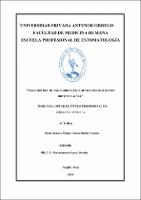Posición del hueso hioides en sujetos con diferente biotipo facial

View/
Download
(application/pdf: 509.7Kb)
(application/pdf: 509.7Kb)
Date
2014Author(s)
Rosales Muñoz, Nadia Shirley Rosalia
Metadata
Show full item recordAbstract
El presente estudio tuvo como propósito determinar la posición del hueso hioides en sujetos con diferente biotipo facial de 10 a 35 años de edad.
El estudio, retrospectivo, transversal, descriptivo y observacional se desarrolló en el ambiente de radiología de la Clínica Estomatológica de la Universidad Privada Antenor Orrego de Trujillo e incluyó un total de 60 radiografías laterales cefalométricas escogidas al azar.
Para determinar las dimensiones de la posición del hueso hioides entre los grupos según biotipo facial se realizó aplicando la prueba Análisis de varianza de un factor y posteriormente, en caso de existir diferencias estadísticamente significativas, se aplicó la prueba de Scheffe.
Previamente a la aplicación de dicha prueba se verificó el cumplimiento de los supuestos de normalidad y homogeneidad de varianzas de los grupos. En caso no se cumplió con dichos supuestos se empleó la prueba Kruskal Wallis y U Mann-Whitney. Se consideró un nivel de significancia del 5%.
Los datos recolectados fueron procesados de manera automatizada en el programa estadístico Stata versión 12, para luego presentar los resultados en tablas de doble entrada mostrando los resultados de acuerdo a los objetivos planteados. This purpose of the study was aimed to determine the position of the hyoid bone in
subjects with different facial biotype 10 to35 years old.
The retrospective, cross-sectional, descriptive and observational study developed in the
environment of radiology at the Stomatology Clinic of the Universidad Privada Antenor
Orrego Trujillo and included a total of 60 cephalometric lateral radiographs chosen at
random.
To determine the size of the position of the hyoid bone between the groups according to
facial biotype was performed using the test analysis of variance, and subsequently if any
statistically significant differences test was applied Scheffe.
Prior to the application of that test compliance with the assumptions of normality and
homogeneity of variances across groups was verified. If you do not meet these
assumptions test was used Kruskal Wallis y U Mann-Whitney. A significance level of
5% was considered.
The data collected were processed in an automated manner in the statistical program
Stata version 12, and present the results in two-way tables showing the results according
to the objectives.
Subject
Collections
- Estomatología [653]

